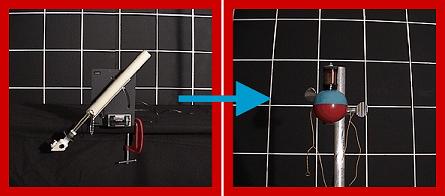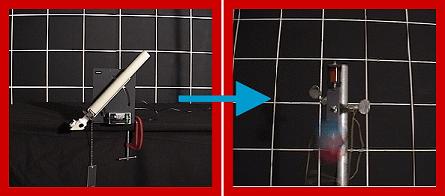A fun demo that shows the independence of horizontal and vertical motion.
Watch Video of the Table-Top Version:
Watch Video of the Simpler Version:
Teachable Topics:
- Projectile Motion
- Free Fall
- Orthogonal Vectors of Motion
Theory:
In this experiment, the hunter's gun is replaced by a spring-and-plunger type ball launcher.
When the plunger is pulled back and locked in place, a battery powers a small electromagnet that holds the "monkey" (a red and blue ball) to its "tree" (a standard laboratory stand).
When the plunger is released, a ball is shot from the gun and the electromagnet is simultaneously turned off (letting the monkey fall).
Imagine for a moment that gravity could be "turned off" - that is, the value of the g, the acceleration due to gravity, could be made zero. If this happened, birds would have trouble swallowing, and using the lavatory would take on a whole new degree of complexity... but the hunter's task would be simple. With no gravity, he'd have only to point his blowgun directly at the monkey and fire. The monkey would let go of his branch and hover in the air (because gravity wouldn't pull him down). The shot would fly in a straight line with some velocity v and, after time t, hit the monkey.


Of course, g isn't zero, but the acceleration due to gravity is the same for both the dart and the monkey. If the hunter now fires his gun directly at the monkey with the same velocity v as before, the horizontal component of v (and therefore the time t for the dart to travel the horizontal distance to the monkey) is the same as before. Since gravity is accelerating both the dart and the monkey downward at the same rate, the dart still hits the monkey!
As you can see in the videos below, this works for any v, whether it's large or small.
Apparatus
- Monkey and Hunter apparatus
- Laboratory stand
- One D battery
- Laser pointer (optional)
Procedure
- Clamp the monkey hunter (ball launcher) and the laboratory stand to the edge of a table. Attach the monkey's electromagnet to the stand, and plug the electromagnet into the hunter.
- Lay a laser pointer against the side of the hunter's barrel, and use it to aim the gun directly at the monkey.
- Pull back the plunger on the hunter and lock it in place to activate the electromagnet. Then attach the monkey to the magnet.
- When ready to show the demo, just release the plunger to "stun"the monkey.
Tips
- The best demonstrations of the monkey and hunter are set up so that they hunter is not too far from the base of the monkey's stand (50 to 60cm is good). With this arrangement, th demonstrator can vary the speed of the projectile and the monkey truly doesn't depend on he projectile's muzzle velocity.
- The battery can easily be jolted out of its case when the gun is fired - just slip it back in when the next shot is fired.



